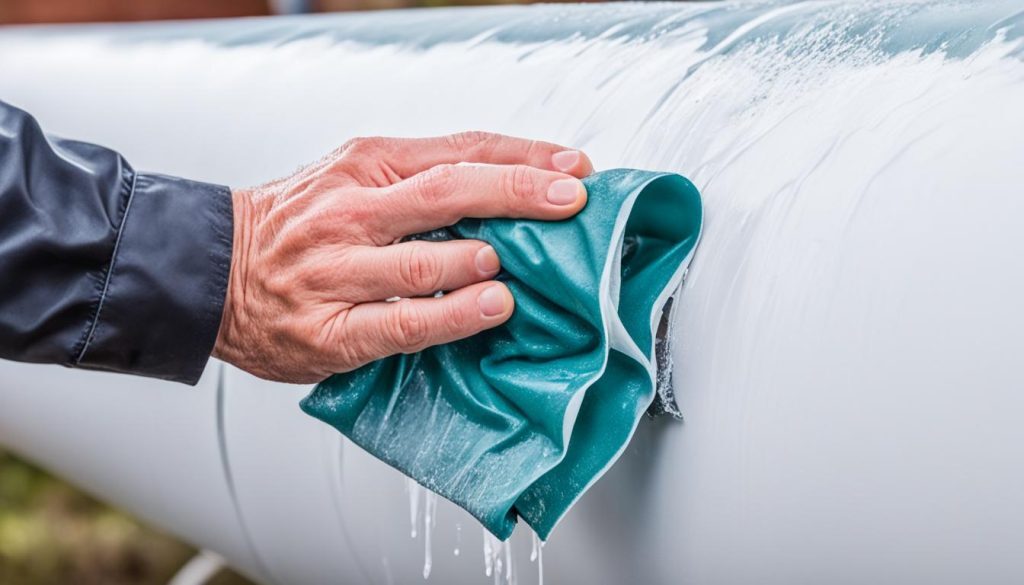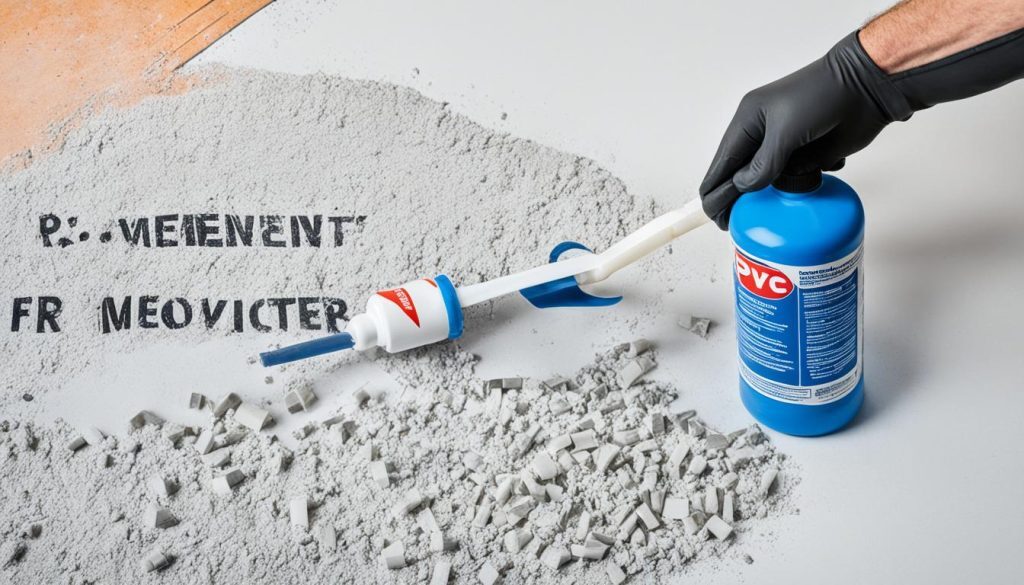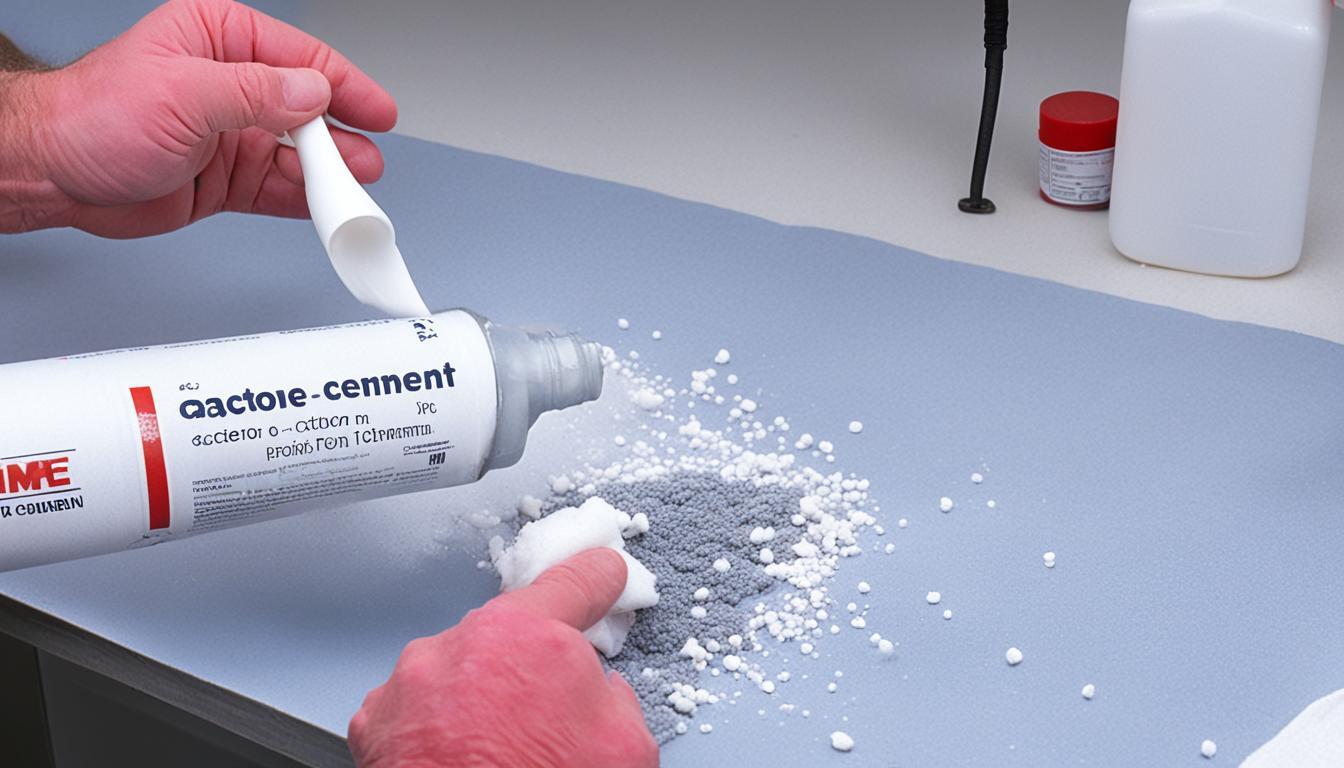Did you know that PVC cement can create incredibly strong bonds that are difficult to remove? Whether you’re dealing with a PVC glue stain on a surface or need to clean up a spill, it’s essential to know the best practices for effective and safe PVC cement removal. In this article, I will share DIY methods and techniques that will help you remove PVC cement without the use of harsh chemicals, saving you time and money.
Key Takeaways:
- Removing PVC cement can be achieved using various methods and techniques
- It’s important to choose the right method based on the specific scenario
- Acetone-based products can help remove PVC glue stains from vinyl flooring
- If the glue has fully dried on a PVC pipe, a special solvent may be necessary
- Cutting out and replacing the pipe is a viable option when all else fails
How to Remove PVC Glue from Vinyl Flooring
If you accidentally get PVC glue or super glue on your vinyl flooring, it’s important to know how to remove it without causing damage. Here’s a step-by-step guide to help you safely and effectively remove PVC glue from your vinyl flooring:
- Start by gently using a small plastic scraper to remove as much of the hardened glue as possible. Be careful not to scratch or damage the vinyl surface.
- Next, dampen a clean cloth with an acetone-based nail polish remover. Make sure the cloth is damp, not soaking wet.
- Dab the acetone-soaked cloth onto the glue stain, focusing on one small area at a time. Avoid rubbing or scrubbing the glue, as it can spread and push it deeper into the vinyl.
- Let the acetone sit on the glue for a few minutes to allow it to penetrate and loosen the bond.
- After a few minutes, gently pry away the loosened glue using the plastic scraper. Repeat this process for any remaining glue spots.
- Once you have removed the glue, use a clean cloth dampened with plain water to wipe away any remaining acetone residue.
- Finally, dry the floor thoroughly with a clean, dry cloth or towel.
It’s important to note that acetone can be harsh on certain types of vinyl flooring, so it’s always a good idea to test it on a small, inconspicuous area first. If the acetone causes any damage or discoloration, stop using it immediately and consider alternative methods or consulting a professional.
Remember, DIY PVC glue removal requires patience and gentle techniques to avoid damaging your vinyl flooring. If you’re unsure or uncomfortable with the process, it’s best to seek professional assistance.
Materials Needed | Instructions |
|---|---|
|
|
How to Remove Glue from a PVC Pipe
Removing glue from a PVC pipe can be a challenging task, but with the right steps, it can be done effectively. Whether you’re dealing with wet or dried PVC glue, there are methods to remove it and restore the clean surface of the pipe.
If you catch the PVC glue while it’s still wet, simply wipe it away with a clean cloth. This quick action can prevent the glue from fully adhering to the pipe and make cleanup easier.
However, if the glue has set and dried on the PVC pipe, you’ll need a stronger solution. Acetone is an effective solvent for removing dried PVC glue. Apply a small amount of acetone on a clean cloth and gently wipe the glue in a circular motion. The acetone will help break down the bond and dissolve the glue. Repeat this process until the glue is completely removed.
In some cases, when the PVC glue has fully dried on the pipe, a special solvent designed for PVC glue removal may be necessary. These solvents are specifically formulated to break down the strong bonds created by PVC cement. Follow the instructions provided with the solvent and use it with caution to avoid damaging the pipe.
It’s important to note that PVC cement acts as a chemical solvent, creating strong bonds between the pipes. Therefore, it may require some effort to remove the glue without causing damage. By using acetone or a special solvent, you can effectively remove PVC glue from a PVC pipe and restore its integrity.

| Glue Removal Method | Effectiveness | Difficulty |
|---|---|---|
| Wiping with a cloth (wet glue) | Low | Easy |
| Acetone | High | Moderate |
| Special solvent | High | Moderate |
Start with the Right Adhesive
Choosing the right adhesive is crucial when it comes to removing PVC glue or super glue. The adhesive you choose can greatly impact the ease of removal and the success of your project. For optimal results, I recommend considering the following adhesives:
- Loctite Power Grab Ultimate Construction Adhesive: This adhesive provides a strong bond and offers enough setting time to reposition parts. It is ideal for various construction projects and allows for easy cleanup.
- Loctite Plastic Bonder: Designed specifically for bonding plastics, this adhesive is perfect for repairing broken plastic parts. It offers excellent strength and durability.
- Loctite Super Glue All Plastics: If you need a rapid, dual-action adhesive for heavy-duty bonds on plastic surfaces, this is the one to choose. It forms a strong bond quickly and is suitable for a wide range of plastics.
By selecting the right adhesive for your specific needs, you can ensure a successful project and make the removal process easier. Now let’s explore some recommendations for removing PVC glue.

| Adhesive | Strength | Setting Time | Recommended Surfaces |
|---|---|---|---|
| Loctite Power Grab Ultimate Construction Adhesive | Strong | Allows repositioning | Various construction materials |
| Loctite Plastic Bonder | Excellent | Dries quickly | Plastic parts |
| Loctite Super Glue All Plastics | Rapid, dual-action | Quick bonding | Wide range of plastics |
Cut Out and Replace the Pipe
When facing stubborn PVC glue that seems impossible to remove, cutting out and replacing the PVC pipe is often the most effective solution. This method is favored by professional plumbers when traditional separation techniques fail. By following these steps, you can remove the PVC glue and replace the affected pipe section:
- Start by identifying the section of the PVC pipe that needs to be removed and replaced. Measure and mark the desired length for the new section.
- Use a PVC pipe cutter or a hacksaw to cut off the marked section of the pipe. Make sure to wear appropriate safety gear, such as gloves and goggles, during the cutting process.
- Ensure that you leave enough space on each side of the cut for the installation of new fittings, such as a coupling or elbow. This will allow for proper connection and functionality.
- After cutting the pipe, it’s important to deburr the cut edges to ensure a smooth connection with the new fittings. Use sandpaper or a deburring tool to remove any rough edges or burrs.
- Once the pipe is cut and deburred, you can proceed with replacing it. Install the new pipe section, ensuring a secure and watertight connection with the fittings.
The process of cutting out and replacing the PVC pipe should be reserved for situations where preserving the existing pipe is not a concern. This method provides a clean and efficient solution when other removal techniques fail, allowing for a fresh installation of the pipe section.
| Pros | Cons |
|---|---|
| – Effective in removing stubborn PVC glue | – Requires cutting and replacing the pipe |
| – Provides a clean installation | – May not be suitable for preserving the existing pipe |
| – Allows for proper connection with new fittings |
Twist the Pipe in Opposite Directions
If cutting and replacing the PVC pipe is not an option, one method you can try is twisting the pipes in opposite directions to break the bond. To do this, you will need a pair of tongue-and-groove pliers. Place one plier on each side of the pipe joint and apply torque by turning the pliers in opposite directions. This twisting motion may help break the glue bond between the pipes.
However, it’s important to be cautious of the pressure applied to the pipe. PVC pipes have low collapse strength compared to other pipes, so excessive force can cause damage. Use a steady and controlled twisting motion to avoid any mishaps.
Remember, twisting the pipe in opposite directions is just one method to separate PVC pipes and remove glue. If this method doesn’t work or you encounter difficulties, there are alternative techniques to try, such as heating the pipe or cutting and replacing the section.
Heat the Pipe with a Heat Gun
When it comes to removing PVC glue and separating pipes, using a heat gun can be an effective method. The heat softens the glue, making it easier to separate the pipes. Here’s how you can use a heat gun to remove PVC glue and separate pipes:
- Start by selecting a heat gun with adjustable temperature settings. This allows you to control the amount of heat applied to the PVC pipe.
- Put on heat-resistant gloves and safety goggles to protect yourself during the process.
- Position the heat gun a few inches away from the area where the pipes are joined.
- Turn on the heat gun and set it to a low temperature.
- Gradually move the heat gun along the length of the PVC pipe, evenly distributing the heat.
- Continue heating the pipe for a few minutes until the PVC glue starts to soften.
- While the glue is still warm and pliable, use tongue-and-groove pliers to twist the pipe in opposite directions.
- Apply gentle pressure to separate the pipes, taking care not to apply excessive force that could damage the pipes.
- If the pipes do not separate easily, continue heating the pipe with the heat gun and repeat the twisting motion until the glue fully loosens.
It’s important to note that this method requires patience and caution. Protect surrounding surfaces from burning or melting by using a heat-resistant mat or covering them with aluminum foil. In some cases, it may be necessary to sacrifice one of the pipes to achieve separation. Remember to coordinate your movements with the heat gun to avoid any accidents or injuries.
Below is an example of how you can use a heat gun to remove PVC glue and separate pipes:
| Materials Needed | Instructions |
|---|---|
| Heat gun | 1. Select a heat gun with adjustable temperature settings. |
| Tongue-and-groove pliers | 2. Put on heat-resistant gloves and safety goggles. |
| Heat-resistant mat or aluminum foil | 3. Position the heat gun a few inches away from the pipe joint. |
| 4. Turn on the heat gun and set it to a low temperature. | |
| 5. Gradually move the heat gun along the length of the pipe. | |
| 6. Continue heating for a few minutes until the glue softens. | |
| 7. Use tongue-and-groove pliers to twist the pipe in opposite directions. | |
| 8. Apply gentle pressure to separate the pipes. | |
| 9. Repeat heating and twisting if necessary until the glue loosens. |
Sand the Pipe to Remove the Glue
If you’ve successfully separated the PVC pipes, sandpaper can be your ally in removing the remaining glue.
Start by using sandpaper with a grit around #220 and gradually move to finer-grit sandpaper to eliminate any grooves left by the glue. Take caution not to sand excessively, as it can remove too much material, making it challenging to properly join the PVC pipe in the future.
Sanding is an effective method for open and accessible materials, such as wood or metal. However, it’s important to note that excessive sanding may compromise the integrity of the PVC pipe, so it’s crucial to strike a balance to ensure optimal results.
